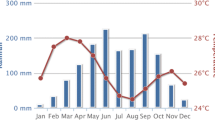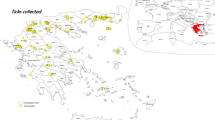Abstract
The cattle tick Rhipicephalus microplus is currently invading the West African region, and little information is available on the spread of this exotic tick in this region. We set out a country-wide field survey to determine its current distribution in Benin. Ticks were collected on cattle from 106 farms selected by random sampling covering all regions of the country. Rhipicephalus annulatus was found on 70 % of all farms, R. decoloratus on 42 %, R. geigyi on 58 %, and R. microplus on 49 %. There is a clear geographic separation between the indigenous Rhipicephalus species and R. microplus. Rhipicephalus annulatus occurs mainly in the northern departments, but it was also observed in lower numbers in locations in the south. The presence of R. decoloratus is limited to the northern region, and in most locations, this tick makes up a small proportion of the collected ticks. The tick R. geigyi tends to be dominant, but occurs only in the four northern departments. The observations concerning R. microplus are entirely different, this species occurs in the southern and central region. The results of this survey confirm the invasive character and displacement properties of R. microplus, since in less than a decade it has colonized more than half of the country and has displaced indigenous ticks of the same genus in many of the sampled locations.



Similar content being viewed by others
References
Aanensen DM, Huntley DM, Feil EJ, Al-Own F, Spratt BG (2009) EpiCollect: linking smartphones to web applications for epidemiology, ecology and community data collection. PLoS ONE 4:e6968
Corson MS, Teel PD, Grant WE (2004) Microclimate influence in a physiological model of cattle-fever tick (Boophilus spp.) population dynamics. Ecol Model 180:487–514
De Castro JJ (1997) Sustainable tick and tickborne disease control in livestock improvement in developing countries. Vet Parasitol 71:77–97
ESA (2012) VECMAP—Mosquito habitat mapping service. http://iap.esa.int/projects/health/vecmap
Estrada-Peña A, Venzal JM (2006) High-resolution predictive mapping for Boophilus annulatus and B. microplus (Acari: Ixodidae) in Mexico and Southern Texas. Vet Parasitol 142:350–358
Evans DE, Martins JR, Guglielmone AA (2000) A review of the ticks (Acari, Ixodida) of Brazil, their hosts and geographic distribution—1. The state of Rio Grande do Sul, Southern Brazil. Mem. Inst. Oswalso Cruz, Rio de Janeiro, vol 95, pp 453–470
Farougou S, Kpodekon M, Tchabode DM, Youssao AKI, Boko C (2006) Seasonal abundance of cattle tick (Acari: Ixodidae) parasites in the Sudanese part of Benin: case of the Atacora and Donga departments. Ann Med Vet 150:145–152
Farougou S, Kpodekon M, Adakal H, Sagbo R, Boko C (2007a) Seasonal abundance of ticks (Acari: Ixodidae) infesting sheep in the southern area of Benin. Revue Med Vet 158:627–632
Farougou S, Tassou AW, Tchabode DM, Kpodekon M, Boko C, Youssao AKI (2007b) Tiques et hémoparasites du bétail dans le nord-Bénin. Revue Med Vet 158:463–467
Hijmans RJ, Cameron SE, Parra JL, Jones PG, Jarvis A (2005) WORLDCLIM: very high resolution interpolated climate surfaces for global land areas. Int J Climatol 25:1965–1978
ICTTD (2007) Surveys to establish the local, provincial or national distribution of ticks. Integrated Consortium on Ticks and Tick-borne Diseases. http://biobel.biodiversity.be/project/show/3010. Newsletter on ticks and tick-borne diseases of livestock in the tropics, nr. 32, pp 6–8
Lempereur L, Geysen D, Madder M (2010) Development and validation of a PCR–RFLP test to identify African Rhipicephalus (Boophilus) ticks. Acta Trop 114:55–58
Madder M (2012a) I-Spot key for the identification of R. Boophilus females. http://www.ispot.org.uk/webkeys/keyintroduction.jsp?selectedKey=webkeys/Rhipicephalus%28Boophilus%29_females.0.1
Madder M (2012b) I-Spot keys for the identification of R. Boophilus males. http://www.ispot.org.uk/webkeys/keyintroduction.jsp?selectedKey=webkeys/Rhipicephalus%28Boophilus%29_males.0.2.
Madder M, Thys E, Geysen D, Baudoux C, Horak I (2007) Boophilus microplus ticks found in West Africa. Exp Appl Acarol 43:233–234
Madder M, Thys E, Achi L, Touré A, De Deken R (2011) Rhipicephalus (Boophilus) microplus: a most successful invasive tick species in West-Africa. Exp Appl Acarol 53:139–145
Madder M, Adehan S, De Deken R, Adehan R, Lokossou R (2012a) New foci of Rhipicephalus microplus in West Africa. Exp Appl Acarol 56:385–390
Madder M, Walker JG, Van Rooyen J, Knobel D, De Clercq EM, Vanwambeke SO, Berkvens D (2012b) e-Surveillance in animal health: use and evaluation of mobile tools. Parasitology/FirstView Articles. Available on CJO. doi:10.1017/S0031182012000571
Pegram RG, David Wilson D, Hansen JW (2000) Past and present national tick control programs: why they succeed or fail. Ann NY Acad Sci, pp 546–554
Pérez De Leán AA, Strickman DA, Knowles DP, Fish D, Thacker E, De La Fuente J, Krause PJ, Wikel SK, Miller RS, Wagner GG et al (2010) One health approach to identify research needs in bovine and human babesioses: workshop report. Parasit Vectors 3:36
Peter TF, Perry BD, O’Callaghan CJ, Medley GF, Shumba W, Madzima W, Burridge MJ, Mahan SM (1998) Distributions of the vectors of heartwater, Amblyomma hebraeum and Amblyomma variegatum (Acari: Ixodidae), in Zimbabwe. Exp Appl Acarol 22:725–740
Vercruysse J, Lafia S, Camicas JL (1982) Les tiques (Amblyommidae) parasites des bovins en République populaire du Benin. Rev Elev Méd Vét Pays Trop 35:361–364
Walker A, Bouattour A, Camicas JL, Estrada-Peña A, Horak IG, Latif AA, Pegram RG, Preston PM (2003) Ticks of domestic animals in Africa: A guide to identification of species. The University of Edinburgh, Edinburgh
Wint W, Robinson TP (2007) Gridded livestock of the world. FAO, Rome
Acknowledgments
We would like to thank the staff of the Direction de l’Elevage (DE) and the Ministry of Agriculture (MAEP) in Benin for their help during the field work. We are very grateful to all people that assisted us during the tick collection, especially the cattle owners and herdsmen. This work was funded by the Belgian Science Policy Programs (Belspo, SR/00/144).
Author information
Authors and Affiliations
Corresponding author
Appendix 1: Collected data
Appendix 1: Collected data
See Table 2.
Rights and permissions
About this article
Cite this article
De Clercq, E.M., Vanwambeke, S.O., Sungirai, M. et al. Geographic distribution of the invasive cattle tick Rhipicephalus microplus, a country-wide survey in Benin. Exp Appl Acarol 58, 441–452 (2012). https://doi.org/10.1007/s10493-012-9587-0
Received:
Accepted:
Published:
Issue Date:
DOI: https://doi.org/10.1007/s10493-012-9587-0




